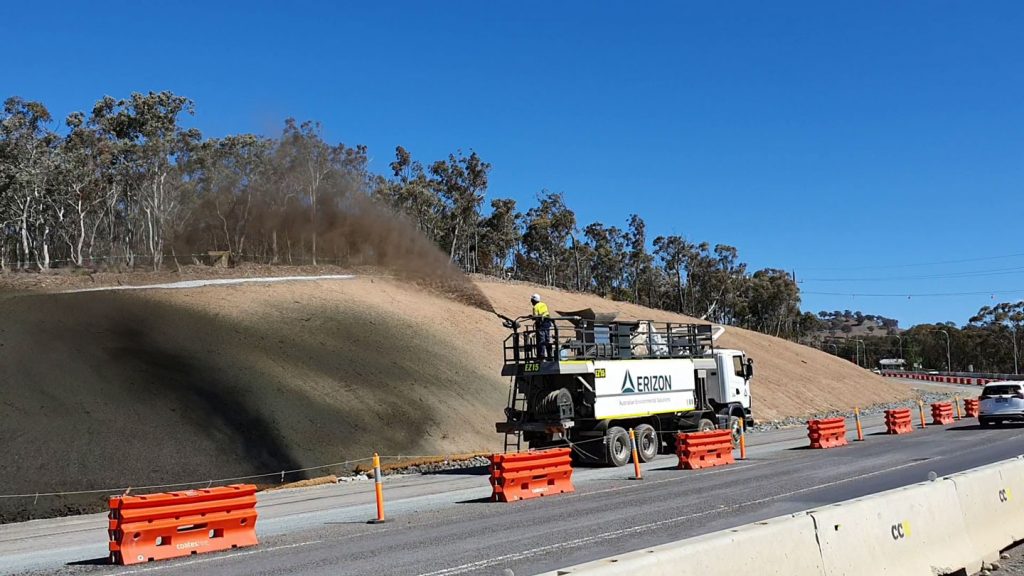The foundation to a successful land rehabilitation project lies in the quality, strength, and stability of the site’s base soil. So, if weak and disturbed soil is present, what can be done? Let’s explore the process, various types of soil stabilisation, and why soil stabilisation is integral to reaching your rehabilitation goals.
What is soil stabilisation?
As a general term, soil stabilisation refers to the process of modifying and restoring soil engineering properties. These properties can include permeability, strength, compaction characteristics and drainage.
The soil stabilisation process will vary depending on the method or type of stabilisation, and the goal of every unique project. At Erizon, we ensure that as much information as possible is collected from the site to ensure an effective and successful soil stabilisation strategy is established. This will include:
- Comprehensive soil testing, with the physical, chemical, and biological characteristics of the soil carefully considered
- Site analysis, including environmental and climatic conditions
- 3D multi-spectral and thermal drone mapping
- Understanding how the soil will perform after stabilisation
- Examining the effects of the soil stabilisation process on nearby structures and surrounding conditions.
Erizon also considers the timing of the soil stabilisation strategy. The earlier this strategy is implemented, the fewer soil modifications will be required, which can save a project considerable time and cost.
The benefits to soil stabilisation will depend on the method or type utilised, but can include:
- Increased soil strength and durability
- Offering erosion control, ultimately reducing potential environmental issues such as wind and rain erosion or wet-dry cycles, while keeping topsoil in place
- Increased soil fertility for vegetation growth, allowing for successful and sustainable revegetation projects
- A reduction in soil plasticity and swelling/shrinkage
- A balanced soil profile suited to the site location and environment.
Types of soil stabilisation
While there are multiple techniques and methods of soil stabilisation, we will explore them under three broad categories: biological, chemical, and mechanical.

Biological soil stabilisation
Where meeting environmental remediation requirements and rehabilitating a site’s ecosystem sustainably is the goal, biological soil stabilisation is most suitable. This method can be achieved through revegetation.
In addition to the benefits of soil stabilisation, revegetation can also stabilise batters through root reinforcement, reduce land degradation, and provide a habitat for biodiversity and animal species.
Case study: WBHO Industrial Soil Stabilisation Project
For a biological soil stabilisation process through revegetation to be successful long-term, good quality soil is imperative. When unstable or depleted soils are present, it is vital to treat this underlying problem. This is where a topsoil enhancement product, such as EnviroSoil, can support the stabilisation process and help in the delivery of full-coverage revegetation.
If vegetation is not an option for the site location, or the land is meant for building, chemical soil stabilisation can be a suitable solution.

Chemical soil stabilisation
Modifying soil properties with the addition of chemically active materials is known as chemical soil stabilisation. There is a range of different additives that can be utilised in chemical soil stabilisation. Once the most appropriate additive has been identified, the process usually involves the substance being diluted with water and sprayed over the soil. The most effective additive in chemical stabilisation will act as a compaction aid, and water repellent and/or binder. Common chemical soil stabilisation methods include:
- Stabilisation using cement – one of the most common and oldest soil stabilisation techniques. The cement works to bind soil particles together, strengthening and stabilising them. Stabilisation using lime is a similar method. However, these methods require significant amounts of energy and are associated with negative environmental issues [1].
- Stabilisation using fly ash – although a cheaper soil stabilisation technique versus cement or lime, fly ash, as a by-product of coal, is declining in popularity. The heavy metals it contains also cause environmental concerns.
- Stabilisation using polymers – the newest method of soil stabilisation. This cost-effective and energy-efficient technique utilises the repeating chains of polymer molecules to bond soil particles together.
At Erizon, we utilise EcoArmour. This eco-friendly synthetic erosion control blanket can stabilise any surface. Binding to substrates such as soil, sand, sandy loam, clay, shale, rock and weathered concrete, this unique mixture of minerals, interlocking fibres, and specialty binders form a durable crust providing stabilisation for up to 20 years.

Mechanical soil stabilisation
In mechanical soil stabilisation, soil properties are improved through the changing of gradation. This includes soil compaction and densification, primarily through the mixing of soils and/or aggregates, or the use of a large compaction force.
While mechanical soil stabilisation may not be appropriate as a sole method of soil stabilisation, it is integral to many other methods.
So, which soil stabilisation type is right for your project? Get in contact with our environmental consultants here to discuss.
[1] Sargent, P 2015, Handbook of Alkali-Activated Cements, Mortars and Concretes








